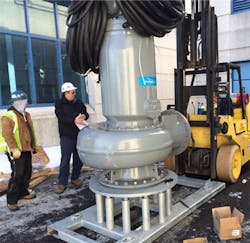The Robert O. Pickard Environmental Centre (ROPEC) is the wastewater treatment plant for the city of Ottawa, ON, handling more than 111 mgd of raw sewage. ROPEC provides secondary level treatment (physical and biological) of domestic, commercial and industrial wastewater, before the treated effluent is returned to the Ottawa River.
Scope
The plant’s raw sewage pumping station has six dry-pit pumps with large 950-hp motors. In 2013, following a detailed condition assessment, the city learned that the condition of three of the six motors was outside acceptable limits, severely affecting their reliability. The motor failure would dramatically reduce the station’s total pumping capacity in the midst of a high-flow season: the spring melt.
The problem with the existing pump motors was exposed after an electrical testing firm confirmed that the insulation in the windings on three of the 950-hp motors had deteriorated to the point where these motors could fail catastrophically.
Solution
While the procurement of new motors started, the least affected of the three motors facing failure had its stator windings cleaned, after which it was reinstalled. This was enough to increase one motor’s reliability. But the city needed additional temporary pumping capacity installed and operational before the high-flow period during the spring runoff. Four pumps were proposed: two Flygt NS-3531s and two Flygt CS-3400s.
The pump station has one common intake that splits into two screening channels and two wet wells. The CS-3400 pumps were mounted in each screening channel, and the NS-3531 pumps were mounted in each wet well. It was also decided to mount the pumps on unique stands above the permanent pump intakes to prevent any flow interference with the remaining operational pumps.
The custom pump stands were designed with hold-down clamps to tightly anchor the pumps without damaging or modifying the galvanized stands. The pump stand legs for the NS-3531 pumps were designed so larger pipes can roll around smaller stationary pipes, preventing solids from catching in the stand and clogging the pump.
The piping contained inside the pumping station was all steel. Pump controls were also an extremely important part of the design, because Class 1, Division 2-rated pumps were being installed in a Class 1, Division 1-rated environment. For this to be acceptable, the pumps could never be energized when any portion of the pumps, other than the cables, was exposed to the atmosphere in the wet well.
Each pump was carefully lowered into place with the discharge elbows and the first length of the discharge pipe already installed. The wet well is quite deep; the liquid level was above the NS-3531, which is 11 ft tall with the stand. The pumps were installed 10 ft above the wet well floor. There are two discharge pipes per channel, as each pump has its own discharge piping. There are no valves in the piping; therefore, when the pumps stop, the piping empties itself back in the wet well, which actually helps keep the pump suction and stands free from rags and debris.
Results
Based on a system curve analysis, a capacity of 66 mgd was expected with all four pumps operating. However when the bypass pumps were commissioned in March 2014, a capacity of 72 mgd was achieved with all four temporary pumps operating. Considering that the city’s consultant had originally requested 56 mgd, all parties were quite pleased to get over 28% more capacity from the pumping system than initially expected.
Obviously, there were many challenges that had to be overcome to make this bypass project a resounding success, right down to the day when the pumps were commissioned. When the pumps were being brought online, one of the CS-3400s would not start. Initially, it was believed that the pump was clogged because it was tripping on high current. However, the culprit turned out to be a defective variable frequency drive, which was quickly replaced within only two days. After almost 800 e-mails, numerous phone calls and several site meetings, this project was completed in a span of only 70 days, from January 6, 2013 to March 17, 2013.
Close cooperation among all stakeholders coupled with innovative design in a narrow frame of time enabled one of Canada’s largest cities to provide the reliable level of service customers expect of their wastewater utility.
Editor's Note: Scranton Gillette Communications and the SGC Water Group are not liable for the accuracy, efficacy and validity of the claims made in this piece. The views expressed in this content do not reflect the position of the editorial teams of Water & Wastes Digest, Water Quality Products and Storm Water Solutions.
